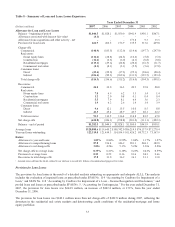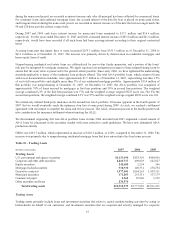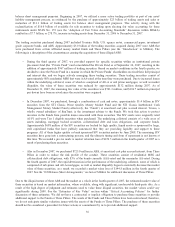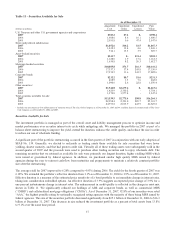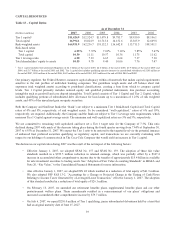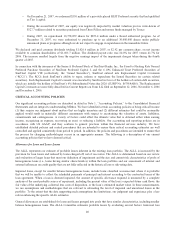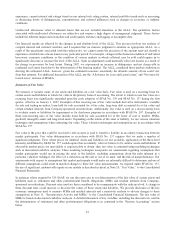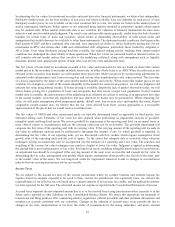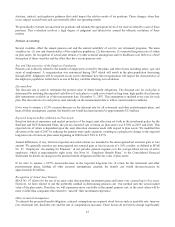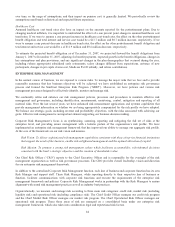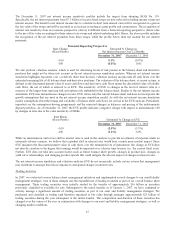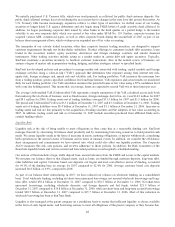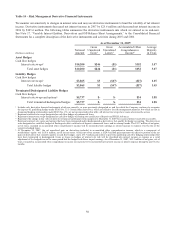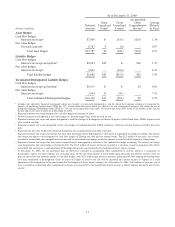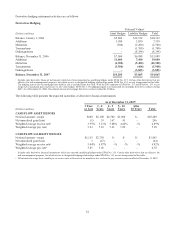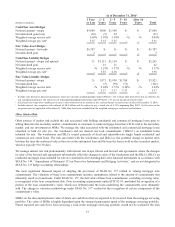SunTrust 2007 Annual Report Download - page 55
Download and view the complete annual report
Please find page 55 of the 2007 SunTrust annual report below. You can navigate through the pages in the report by either clicking on the pages listed below, or by using the keyword search tool below to find specific information within the annual report.statutory, judicial, and regulatory guidance that could impact the relative merits of tax positions. These changes, when they
occur, impact accrued taxes and can materially affect our operating results.
We periodically evaluate our uncertain tax positions and estimate the appropriate level of tax reserves related to each of these
positions. This evaluation involves a high degree of judgment and subjectivity around the ultimate resolution of these
matters.
Pension Accounting
Several variables affect the annual pension cost and the annual variability of cost for our retirement programs. The main
variables are: (1) size and characteristics of the employee population, (2) discount rate, (3) expected long-term rate of return
on plan assets, (4) recognition of actual asset returns, (5) other actuarial assumptions and (6) healthcare cost. Below is a brief
description of these variables and the effect they have on our pension costs.
Size and Characteristics of the Employee Population
Pension cost is directly related to the number of employees covered by the plans, and other factors including salary, age, and
years of employment. A reorganization was announced during 2007 which will result in the plan population decreasing
through 2008. Judgments will be required on our part to determine how this reorganization will impact the characteristics of
the employee population, listed above as one of the key variables affecting our calculation.
Discount Rate
The discount rate is used to determine the present value of future benefit obligations. The discount rate for each plan is
determined by matching the expected cash flows of each plan to a yield curve based on long term, high quality fixed income
debt instruments available as of the measurement date, December 31, 2007. This assumption is updated every year for each
plan. The discount rate for each plan is reset annually on the measurement date to reflect current market conditions.
If we were to assume a 0.25% increase/decrease in the discount rate for all retirement and other postretirement plans, and
keep all other assumptions constant, the benefit cost would decrease/increase by approximately $13 million.
Expected Long-term Rate of Return on Plan Assets
Based on historical experience and market projection of the target asset allocation set forth in the investment policy for the
SunTrust and NCF Retirement Plans, the pre-tax expected rate of return on plan assets was 8.50% in 2007 and 2006. This
expected rate of return is dependent upon the asset allocation decisions made with respect to plan assets. We modified this
allocation at the end of 2007 by reducing the pension trust equity exposure, resulting in a prospective change to the expected
long-term rate of return on plan assets beginning in 2008 from 8.50% to 8.25%.
Annual differences, if any, between expected and actual returns are included in the unrecognized net actuarial gain or loss
amount. We generally amortize any unrecognized net actuarial gain or loss in excess of a 10% corridor, as defined in SFAS
No. 87, “Employers’ Accounting for Pensions,” in net periodic pension expense over the average future service of active
employees, which is approximately eight years. See Note 16, “Employee Benefit Plans,” to the Consolidated Financial
Statements for details on changes in the pension benefit obligation and the fair value of plan assets.
If we were to assume a 0.25% increase/decrease in the expected long-term rate of return for the retirement and other
postretirement plans, holding all other actuarial assumptions constant, the benefit cost would decrease/increase by
approximately $6 million.
Recognition of Actual Asset Returns
SFAS No. 87 allows for the use of an asset value that smoothes investment gains and losses over a period up to five years.
However, we have elected to use the preferable method in determining pension cost. Our method uses the actual market
value of the plan assets. Therefore, we will experience more variability in the annual pension cost, as the asset values will be
more volatile than companies who elected to “smooth” their investment experience.
Other Actuarial Assumptions
To estimate the projected benefit obligation, actuarial assumptions are required about factors such as mortality rate, turnover
rate, retirement rate, disability rate and the rate of compensation increases. These factors do not tend to change significantly
43


